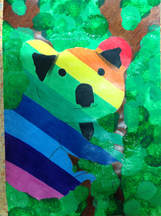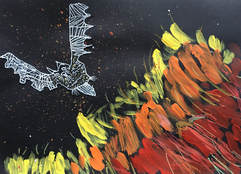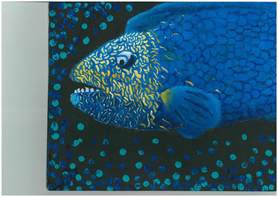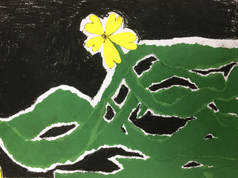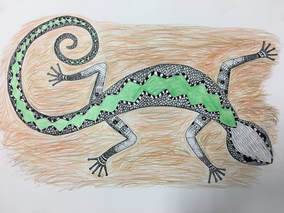HOW TO ENTER
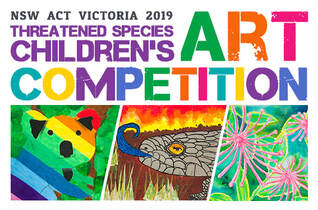
Instructions for the artist:
1. Research
Do your own research on one threatened animal or plant in your state. A list of threatened species for NSW can be found or on http://www.environment.nsw.gov.au/threatenedSpeciesApp/ Some plants and animals are listed in our Gallery and more information can be found in a list at the end of this section. You could look for a species that is threatened in your own area, or one that used to live in your area but is now extinct there. You could find out the reasons that species is threatened, such as logging, land-clearing or feral animals.
2. Create
Create your own work of art that interprets this theme. Make sure it falls within the categories of drawing, painting or mixed media (such as collage). Three dimensional, photography, digitally created work and video works can’t be accepted. Please make sure it is your OWN WORK. Copying the shape and form of a species is fine as long as you make it your own creation. Tracing, or having a parent or anyone else work on any part of your entry is not allowed.
3. Reflect
The reflection is a short piece of writing that describes what inspired you to depict that species. It should be 50-150 words long and can be included in the registration form. This will help the judges understand more about you and your work. Parents or teachers can help younger children to fill in this section.
4. Send
Please ask for an adult's assistance to create a clear digital copy of your artwork under 5MB in size. The file should be sent to the competition organiser in digital format, along with a Registration Form that must be completed by a parent, teacher or legal guardian.
RESEARCH STARTS HERE FOR NSW
http://www.environment.nsw.gov.au/threatenedSpeciesApp/
http://plantnet.rbgsyd.nsw.gov.au/search/spatial.htm
http://www.edonsw.org.au/native_plants_animals
http://www.environwww.environment.nsw.gov.au/topics/animals-and-plants/threatened-species/about-threatened-speciesment.nsw.gov.au/t
https://www.smh.com.au/environment/here-are-13-remarkable-animals-facing-extinction-in-nsw--and-there-are-hundreds-more-20150416-1mmmrv.htmlopics/animals-and-plants/threatened-species/about-threatened-species
http://www.abc.net.au/news/2017-06-03/secret-cabinet-document-shows-aussie-animals-at-risk/8583672
http://www.firesticks.org.au/nsw-indigenous-protected-areas-a-sanctuary-for-threatened-species/
1. Research
Do your own research on one threatened animal or plant in your state. A list of threatened species for NSW can be found or on http://www.environment.nsw.gov.au/threatenedSpeciesApp/ Some plants and animals are listed in our Gallery and more information can be found in a list at the end of this section. You could look for a species that is threatened in your own area, or one that used to live in your area but is now extinct there. You could find out the reasons that species is threatened, such as logging, land-clearing or feral animals.
2. Create
Create your own work of art that interprets this theme. Make sure it falls within the categories of drawing, painting or mixed media (such as collage). Three dimensional, photography, digitally created work and video works can’t be accepted. Please make sure it is your OWN WORK. Copying the shape and form of a species is fine as long as you make it your own creation. Tracing, or having a parent or anyone else work on any part of your entry is not allowed.
3. Reflect
The reflection is a short piece of writing that describes what inspired you to depict that species. It should be 50-150 words long and can be included in the registration form. This will help the judges understand more about you and your work. Parents or teachers can help younger children to fill in this section.
4. Send
Please ask for an adult's assistance to create a clear digital copy of your artwork under 5MB in size. The file should be sent to the competition organiser in digital format, along with a Registration Form that must be completed by a parent, teacher or legal guardian.
RESEARCH STARTS HERE FOR NSW
http://www.environment.nsw.gov.au/threatenedSpeciesApp/
http://plantnet.rbgsyd.nsw.gov.au/search/spatial.htm
http://www.edonsw.org.au/native_plants_animals
http://www.environwww.environment.nsw.gov.au/topics/animals-and-plants/threatened-species/about-threatened-speciesment.nsw.gov.au/t
https://www.smh.com.au/environment/here-are-13-remarkable-animals-facing-extinction-in-nsw--and-there-are-hundreds-more-20150416-1mmmrv.htmlopics/animals-and-plants/threatened-species/about-threatened-species
http://www.abc.net.au/news/2017-06-03/secret-cabinet-document-shows-aussie-animals-at-risk/8583672
http://www.firesticks.org.au/nsw-indigenous-protected-areas-a-sanctuary-for-threatened-species/
Submission instructions for Parents, teachers or program managers
- Please assist your child/student to create a clear digital copy of their original artwork of no more than 5MB to send to the organiser via the ACF website (www.acf.org.au/artcomp)
- To upload an entry, you can either scan a copy of the artwork or take a photograph.
- If a teacher or program manager is registering the child then it will be assumed that they have received any necessary parental consent.
- For group entries, where a number of children are working on a single artwork (open only to schools and other programs), please use the form for Groupwork on the ACF site.
- Only one individual work can be submitted for each child, but the same child can submit work as part of a Groupwork entry.
- The on-line entry forms will be open from 9am on June 5, 2021 to 5pm on July 30, 2021. All submissions must be received by July 30. Entries received after that date will not be accepted.
- Entry Guidelines Summary
- 1. The competition will be open to all children in Australia aged 5-12 years.
2. Original artwork needs to be either a painting, a drawing, or mixed media work such as a collage. Three dimensional work, photographs, digitally created work and videos are not accepted.
3. Entries can be made from any traditional media, including pastel, oils pastel, pen, pencil, charcoal, acrylics, watercolour, oils, mixed media, collage, or found materials.
4. Individual artworks should be A3 in size, although dimensions may vary. Individual entries up to A2 in size will be accepted. Groupwork entries should be no more than 2 metres x 1.5 metres.
5. Children have to research their chosen species and write a short (50-150 word) explanation of why they chose their particular animal or plant. This explanation forms part of the competition entry requirements.
6. A parent or teacher photographs the child’s work and submits the photo online with a registration form and the child's explanation of the artwork.
- Additional information: At the end of the entry period (after July 30) the submissions will be assessed. Seventy finalists will be chosen for an exhibition to be hung in Sydney for two weeks in September.
- If a child's artwork has been shortlisted for hanging in the exhibition, the parent or teacher will be advised by email. The child's original artwork must be sent by mail or delivered to the Organiser by a date to be announced, but within a few weeks after July 30.
- PLEASE KEEP THE ORIGINAL ARTWORK UNTIL THE FINALISTS ARE ANNOUNCED IN EARLY AUGUST. THE ARTWORK CANNOT BE SELECTED FOR THE EXHIBITION UNLESS WE ARE ABLE TO RECEIVE THE ORIGINAL WORK.
- The winners will be chosen out of the finalists, and these will be be assessed by the Judging Panel before the opening of the exhibition. A prize-giving ceremony and launch will be held. Prize winners will be announced at the launch.
- First and second prizes will be awarded in the categories of 5-7 year olds, 8-10 year olds, 11-12year olds, Best Plant entry, Most Unusual Entry and Best Groupwork. A prize will be given for the Best Written Description.
- All finalists work will also be shared on social media and will remain on the Finalists page of the website.
- Parents and teachers are invited (not compulsory) to take a short 3min phone video of their child/ren talking about the plant or animal, their process or simply a video of the artist at work and submit that separately via our email address- [email protected]
- CLICK HERE TO GO TO THE INDIVIDUAL ELECTRONIC ENTRY FORM
- CLICK HERE TO GO TO THE GROUP ELECTRONIC ENTRY FORM
ENTRY GUIDELINES FOR GROUPWORKS FOR TEACHERS AND ART COORDINATORS
- Groupwork projects are individual artworks completed collectively by a number of children. They are open only to schools and other art programs.
- A school or art program can submit individual artworks by children in a class, and a Groupwork as well, created by the same children.
- The work should be no more than 2 metres x 1.5 metres in dimensions, and other than that the same criteria apply as for the individual work - two dimensional, original, paint, pencil or mixed media based. Try to ensure that the original can be easily rolled up and sent by post because if it makes the finals we will need the artwork sent to us and postage can be expensive.
- The teacher can help get ideas together and co-ordinate the project, as long as only the children are working on it. Each child can do a component, and these can be cut out and assembled later if preferred.
- A group could be a whole class, but three is a minimum. Generally we have found that an artwork entry with two members could just as easily have been done by one. If you have a very big group though you might want to consider dividing up the class and doing a few different Groupworks. It gets a bit unwieldy if a lot of children are working on one piece, and of course, some will contribute more than others.
- For the written component there is only one to be submitted for each group - the best idea is if the teacher gathers comments from the children and summarizes their thoughts or chooses the one or two best ones to represent the group. The written comments for the group entries can be longer than 150 words, but it is best to keep them under 250.
